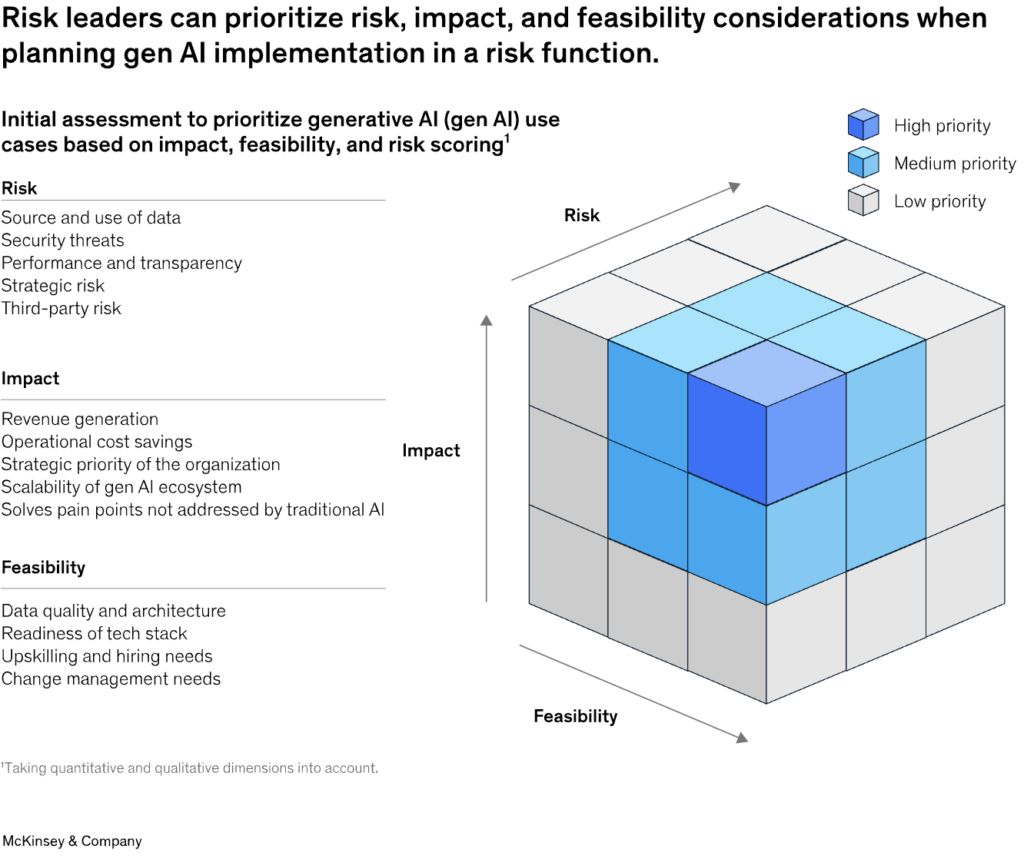Generative artificial intelligence (AI), also known as gen AI, is expected to significantly impact risk management over the next five years, allowing financial institutions to automate tasks, accelerate processes and improve efficiencies.
But in order to leverage the benefits of gen AI, risk and compliance functions must establish clear guidelines and frameworks that not only address inbound risks from gen AI but which also ensure the responsible usage of gen AI, a new paper by McKinsey says.
The report, discusses the potential impact of gen AI on risk management within financial institutions, exploring the benefits of the technology in enhancing processes and efficiencies, as well as delving into the important considerations associated with adopting gen AI.
According to the paper, gen AI has the potential to transform the way banks manage risks over the next three to five years by allowing functions to move away from routine tasks towards partnering with business departments to prevent strategic risks from the start of new customer experiences.
This shift could give risk professionals more time to advise on new products, analyze risk trends, and improve risk processes before issues arise.
The report notes that several institutions have already started exploring the use of gen AI in risk management, citing regulatory compliance, financial crime, credit risk, modeling and data analytics, cyber risk and climate risk as emerging use cases.
How enterprises can leverage generative AI for risk management
In regulatory compliance, the report says that enterprises are using gen AI as a virtual regulatory and policy expert. These companies are training gen AI systems to answer questions about regulations, company policies and guidelines.
In financial crime, gen AI is used to generate suspicious-activity reports based on customer and transaction information, and improve transaction monitoring. The tech is also used to automate the creation and update of customers’ risk ratings based on changes in their know-your-customer (KYC) attributes, the report says.
In credit risk, gen AI is able to summarize customer information to inform credit decisions, ultimately helping accelerate banks’ end-to-end credit process. Following a credit decision, gen AI can draft the credit memo and contract.
In modeling and data analytics, gen AI is able to automate the monitoring of model performance and generate alerts if metrics fall outside tolerance levels. The tech can also draft model documentation and validation reports.
In cyber risk, gen AI can use natural language to check cybersecurity vulnerabilities and generate code for detection rules. The tech can also serve as a virtual expert for investigating security data.
Finally, in climate risk, gen AI can suggest code snippets, facilitate unit testing, and assist physical-risk visualization with high-resolution maps. The tech can automate data collection for counterparty transition risk assessments and generate early-warning signals based on trigger events. It can also automatically produce reports on environmental, social, and governance (ESG) topics and sustainability sections of annual reports.
Key considerations when adopting generative AI for risk management
The report discusses the key considerations in adopting gen AI within risk management functions of financial institutions. It emphasizes the importance of prioritizing use cases that maximize value all the while ensuring responsible and sustainable adoption of the technology.
The report highlights three critical dimensions when assessing the prioritization of use cases, emphasizing risk, impact and feasibility. These assessments should align with the overall vision for gen AI, comply with relevant regulations and consider data sensitivity, the report says.

Critical dimensions to assess prioritization of generative AI use cases, Source: How generative AI can help banks manage risk and compliance, McKinsey, Mar 2024
McKinsey advises financial institutions to start with a focused approach, prioritizing three to five risk and compliance use cases that align with their strategic goals. These use cases can be executed in three to six months, followed by an estimation of business impact, the report says.
However, McKinsey warns that the introduction of gen AI presents new risks, requiring financial institutions to embrace a new approach to risk management and controls. It recommends risk functions to remain vigilant at the enterprise level and take steps such as ensuring awareness across the organization, updating model identification criteria, developing gen AI risk experts, and revisiting existing controls.
Additionally, organizations must recognize the significant data and tech demands associated with gen AI systems, and understand the talent requirements for adopting gen AI.
The potential of generative AI in financial services
Gen AI has emerged as a powerful force in the financial services sector, promising tremendous opportunities. The McKinsey Global Institute estimates that gen AI could lift productivity by 3% to 5% across the banking sector, delivering value equal to an additional US$200 billion to US$340 billion in annual revenues.
A 2023 survey conducted by KPMG of 300 global executives across a wide range of industries found that executives in the financial sector are adopting gen AI at a faster pace than any other industry.
38% of the financial services leaders polled said that their executive leadership team had appropriately prioritized the technology, versus 26% of all survey respondents. 26% said their organization had already implemented at least one AI solution or plans to do so within the next six months, versus 21% of all executives.
Financial services companies are also ramping up investments in gen AI. 64% of the financial executives surveyed said that their organization was prepared to allocate budget to the technology over the next 6 to 12 months, versus 50% of all organizations.
But the potential of gen AI extends well beyond financial services. Goldman Sachs estimates that gen AI could drive a 7% increase in global gross domestic product (GDP), translating to almost US$7 trillion. The bank says that roughly two-thirds of US occupations are exposed to some degree of automation by AI.
Featured image credit: Edited from freepik
- SEO Powered Content & PR Distribution. Get Amplified Today.
- PlatoData.Network Vertical Generative Ai. Empower Yourself. Access Here.
- PlatoAiStream. Web3 Intelligence. Knowledge Amplified. Access Here.
- PlatoESG. Carbon, CleanTech, Energy, Environment, Solar, Waste Management. Access Here.
- PlatoHealth. Biotech and Clinical Trials Intelligence. Access Here.
- Source: https://fintechnews.sg/94699/ai/mckinsey-generative-ai-risk-management/





